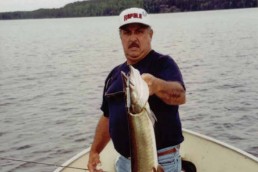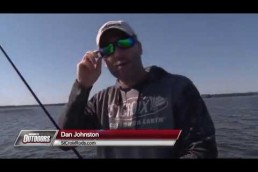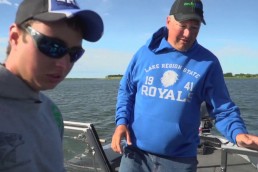Cool Spring Weather on Kinkaid Lake means Muskie Action
SHARE THIS POST
Starting in late March and on through May when the days are continuing to get longer, the nights are still cool. This is the time the serious muskie fishermen are waiting for. The waters are warming up more, and these saber-toothed fish will frequent the deeper, cooler, less accessible recesses of its habitat at or near a thermocline, if there is one. Muskies do this all in the hopes of staying more comfortable during hot summer months. But in May, these will return to more plentiful, shallower hunting grounds to feed on the good supply of baitfish available them. This is especially true on Kinkaid Lake.
The feeding frenzies muskies go through supply them with enough “groceries” to grow larger and larger as the season progresses. The muskie is never an easy mark, as its wary instincts make it more challenging. But this species is more vulnerable to a hook and line in spring. With a little perseverance, even a novice can get lucky and hook into a battling muskie. In southern Illinois, Kinkaid Lake has 2,750 acres of excellent fishing for bass, crappies and walleyes, but that’s another story—muskies are what makes this lake great. The water here has a maximum depth of 72 feet with 92 miles of irregular shoreline, with only 10 percent of Kinkaid having less than 10 feet of depth. The water is moderately infertile with light-brown-to-clear clarity and an aforementioned thermocline that develops in late June in at about 22 feet. This thermocline will last into late September, and if you do fish below that depth, dissolved oxygen is depleted and you will be wasting your time.
It can’t hurt to learn more of the muskies’ idiosyncrasies in Kinkaid. The natural habitats for this species of course are the first places to look—weed beds in and around breaklines and drop-offs, stumps and stick-ups adjacent to deeper water, etc. But now you have to add into the equation some of the forage of these muskies. Besides the many gizzard shad, this opportunistic feeder loves the soft-rayed spotted sucker that is abundant in this lake. By knowing some of the habits and patterns of these spotted suckers, you can then increase your chances of catching a giant muskie. This species of baitfish prefers areas with a slight current and some turbidity in areas with a softer bottom and older plant material. Large necks with run-ins or narrow areas that increase current flow are areas you should be looking for.
There are many notable muskie hideouts. You can work the shelves between Buzzard Point and Thompson Neck. Here, you can cast and work large spinnerbaits in black and gold down the drop-offs along the shore or troll Rapala Magnums, Rapala Slivers and Grandmas along the breaklines. The stumps and laydowns just below Buzzard are also an excellent location to coax out a “snapper” of a muskie. The back part of Cochran Bay is another excellent location. Inline spinners could get you an arm-jolting strike. Again, a black and gold lure would be my first choice. And be sure to work the stump fields methodically.
Are you enjoying this post?
You can be among the first to get the latest info on where to go, what to use and how to use it!
Other locations that can do well are Barone and Miller bays, Raymond Neck and the area just below Levan Neck. At Levan, there’s a large shallow flat that extends nearly to the opposite shore and was the location of an old roadbed. That roadbed is all but gone, but if you work around the stumps and foundations that still remain you may find them.
These are just a few of the many muskie-holding areas Kinkaid Lake has to offer now. There are many more hot spots, but I don’t want to turn this into a novel.
Although Lake Shelbyville in south-central Illinois now waves the banner for bragging rights to the state-record muskie at 50 3/4 inches at 38 pounds, 8 ounces, I believe that Lake Kinkaid has all the qualifications for producing a state-record fish too. This lake has produced numerous catches in the 50-inch range and more at 30 to 40 inches, so it is more a matter of “when” not “if” the record changes hands. Maybe you’ll be the lucky one.
MWO
SHARE THIS POST
Did you enjoy this post?
You can be among the first to get the latest info on where to go, what to use and how to use it!
Herman Kunz
Herman Kunz is a freelance writer specializing in all types of hunting, freshwater fishing and other outdoor-related activities, including seminar speaking and promotions. Kunz is on the field advisory staffs of Rapala, Flambeau tackle systems and Storm Lures, and may be reached at 618-599-2400.



